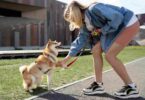Training a dog is a rewarding experience, but when it comes to deaf or blind dogs, the process can present some unique challenges. However, these special needs don’t mean that a dog can’t lead a happy, healthy, and well-behaved life. In fact, with the right training methods and a little creativity, you can develop a strong bond with your dog and help them navigate the world with confidence. Whether your dog is deaf, blind, or both, they have the ability to learn, communicate, and adapt—it’s simply a matter of finding the right approach.
1. Understanding Deaf and Blind Dogs: Different Senses, Same Needs
Deaf and blind dogs experience the world differently from their hearing and sighted counterparts, but that doesn’t make them any less capable. Deaf dogs rely heavily on their other senses—especially their sense of smell and vibration—while blind dogs navigate through spatial memory and enhanced hearing. Understanding these differences is essential for creating effective training strategies. While their experiences may be unique, they still share the same basic needs for love, companionship, and stimulation. The key is learning how to communicate with them in a way that respects their limitations while harnessing their strengths.
2. Building a Strong Foundation: Establishing Trust Through Non-Verbal Cues
When training deaf or blind dogs, communication is everything. Since they can’t rely on the traditional verbal commands or visual cues that other dogs respond to, non-verbal communication becomes the foundation of your relationship. For deaf dogs, you can use hand signals, light cues, or vibrations to communicate. Start with simple gestures and reinforce them with positive rewards. For blind dogs, you can use sound cues like a specific whistle or tapping noises to grab their attention. Both types of dogs rely on body language to understand their surroundings, so using clear and consistent physical gestures will create a foundation of trust. Remember, communication isn’t just about the signals you send—it’s about learning to read their body language too, so you can pick up on their emotional state and adapt accordingly.
3. Creating a Sensory-Rich Environment: Encouraging Exploration
Deaf and blind dogs might not see or hear the world the way we do, but that doesn’t mean they can’t enjoy it just as much. A sensory-rich environment helps stimulate their other senses and can make a huge difference in their ability to learn and adapt. For a blind dog, you can use different textures in their environment, like rugs or mats, to help them navigate spaces. Scented toys or food trails can guide them to specific areas. For a deaf dog, vibration toys or floor taps can signal playtime or activities. The more you provide sensory stimulation, the more your dog will learn to explore their environment with confidence.
4. Positive Reinforcement: The Power of Rewarding Success
Just like any other dog, deaf or blind dogs respond incredibly well to positive reinforcement. Rewarding your dog with treats, affection, or toys when they exhibit desired behavior encourages them to repeat those actions. This method is particularly powerful when training special-needs dogs, as it reinforces good behavior and fosters a sense of accomplishment. For a deaf dog, you can pair the hand signals with a consistent, rewarding touch or a vibration (such as tapping your hand on the floor). For a blind dog, verbal praise coupled with a treat or rub can provide the positive reinforcement they need to feel motivated. Consistency is key—ensure that the rewards are clear and immediate so your dog associates the action with the positive outcome.
5. Tailored Commands: Customizing Cues for Your Dog’s Needs
Training a deaf or blind dog requires flexibility and creativity when it comes to command modification. For deaf dogs, you can establish a set of clear, consistent hand signals that become their ‘language.’ These can range from basic commands like “sit” or “stay” to more complex ones, depending on your dog’s progress. The key is to ensure that the gestures are distinct and easy for your dog to differentiate. For blind dogs, sound cues or a particular vibration can be used in place of visual signals. For example, you can use the sound of a bell or a whistle to alert your dog that a particular action is required. Tailoring the commands to suit your dog’s strengths allows you to effectively communicate with them, despite their sensory limitations.
6. Safety First: Creating a Secure Environment
When training a deaf or blind dog, safety is a priority. Blind dogs, especially, need to be given an environment that’s free from hazards. Clear any obstacles, sharp edges, or clutter that could pose a danger to them as they navigate through your home. You can also use sound-marked objects or even gentle taps on the floor to guide them when they are moving through new spaces. For deaf dogs, you need to be mindful of their ability to hear potential dangers like oncoming traffic or other animals. Consider using a harness with a reflective vest or a collar with a tag that alerts others to the dog’s deafness, so they’re aware and can approach them with care. Ensuring their environment is safe and predictable will help them feel secure and minimize the chances of accidents.
7. Socialization: Helping Them Navigate the World
Deaf and blind dogs need socialization just as much as any other dog, but the approach may need to be modified. For a deaf dog, the challenge is often ensuring they remain calm and well-behaved around other animals or people, especially if they are startled or caught off guard. Blind dogs, on the other hand, must learn to rely on their other senses to interact with others and understand their surroundings. Gradual introductions to new people, dogs, and environments will help them feel more comfortable. Positive socialization experiences, coupled with clear cues, help both deaf and blind dogs adapt to new situations without fear or anxiety. By socializing them slowly and patiently, you allow them to develop confidence in themselves and their ability to navigate the world around them.
8. Patience and Consistency: The Cornerstones of Success
Training a deaf or blind dog may take longer than training a dog with full sensory capabilities, but the process is just as rewarding. The most important thing to remember is that patience and consistency are the cornerstones of success. Deaf and blind dogs are fully capable of learning—they simply need time, creative solutions, and a consistent routine. Celebrate every small victory, and be gentle with your expectations. By creating a strong bond with your dog through trust, understanding, and mutual respect, you’ll be amazed at how quickly they can adapt and flourish.




